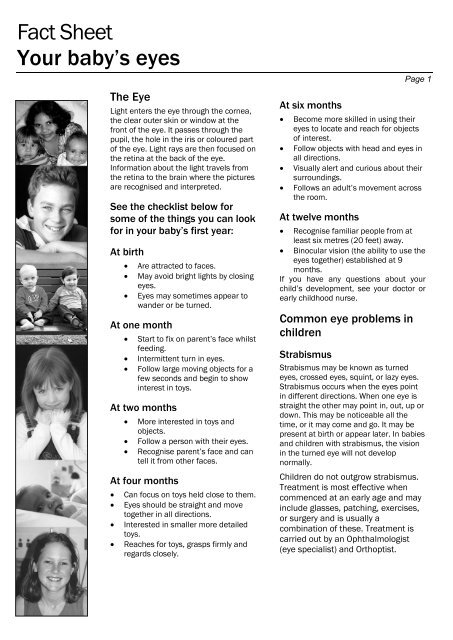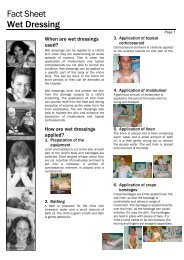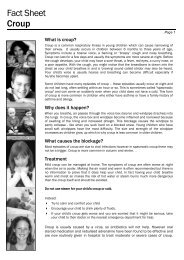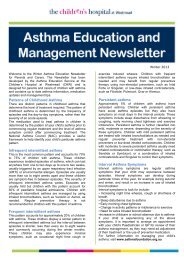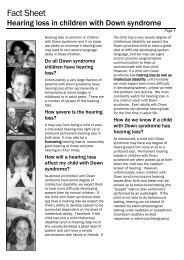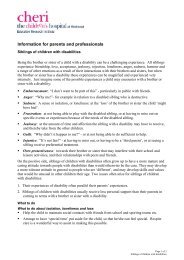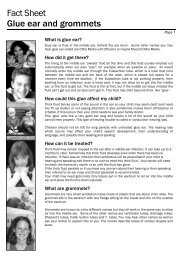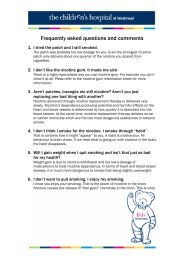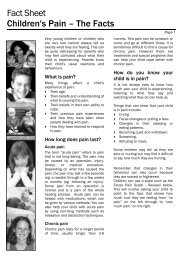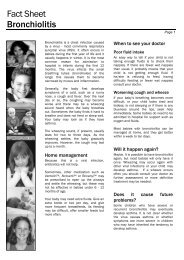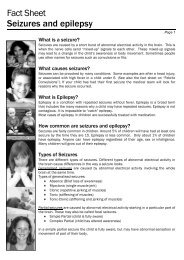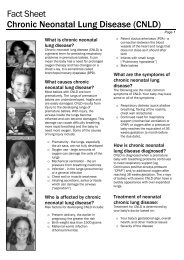Fact Sheet Your baby's Eyes - Kids Health @ CHW
Fact Sheet Your baby's Eyes - Kids Health @ CHW
Fact Sheet Your baby's Eyes - Kids Health @ CHW
You also want an ePaper? Increase the reach of your titles
YUMPU automatically turns print PDFs into web optimized ePapers that Google loves.
<strong>Fact</strong> <strong>Sheet</strong><br />
<strong>Your</strong> baby’s eyes<br />
xcvxcvxcv<br />
The Eye<br />
Light enters the eye through the cornea,<br />
the clear outer skin or window at the<br />
front of the eye. It passes through the<br />
pupil, the hole in the iris or coloured part<br />
of the eye. Light rays are then focused on<br />
the retina at the back of the eye.<br />
Information about the light travels from<br />
the retina to the brain where the pictures<br />
are recognised and interpreted.<br />
See the checklist below for<br />
some of the things you can look<br />
for in your baby’s first year:<br />
At birth<br />
• Are attracted to faces.<br />
• May avoid bright lights by closing<br />
eyes.<br />
• <strong>Eyes</strong> may sometimes appear to<br />
wander or be turned.<br />
At one month<br />
• Start to fix on parent’s face whilst<br />
feeding.<br />
• Intermittent turn in eyes.<br />
• Follow large moving objects for a<br />
few seconds and begin to show<br />
interest in toys.<br />
At two months<br />
• More interested in toys and<br />
objects.<br />
• Follow a person with their eyes.<br />
• Recognise parent’s face and can<br />
tell it from other faces.<br />
At four months<br />
• Can focus on toys held close to them.<br />
• <strong>Eyes</strong> should be straight and move<br />
together in all directions.<br />
• Interested in smaller more detailed<br />
toys.<br />
• Reaches for toys, grasps firmly and<br />
regards closely.<br />
At six months<br />
Page 1<br />
• Become more skilled in using their<br />
eyes to locate and reach for objects<br />
of interest.<br />
• Follow objects with head and eyes in<br />
all directions.<br />
• Visually alert and curious about their<br />
surroundings.<br />
• Follows an adult’s movement across<br />
the room.<br />
At twelve months<br />
• Recognise familiar people from at<br />
least six metres (20 feet) away.<br />
• Binocular vision (the ability to use the<br />
eyes together) established at 9<br />
months.<br />
If you have any questions about your<br />
child’s development, see your doctor or<br />
early childhood nurse.<br />
Common eye problems in<br />
children<br />
Strabismus<br />
Strabismus may be known as turned<br />
eyes, crossed eyes, squint, or lazy eyes.<br />
Strabismus occurs when the eyes point<br />
in different directions. When one eye is<br />
straight the other may point in, out, up or<br />
down. This may be noticeable all the<br />
time, or it may come and go. It may be<br />
present at birth or appear later. In babies<br />
and children with strabismus, the vision<br />
in the turned eye will not develop<br />
normally.<br />
Children do not outgrow strabismus.<br />
Treatment is most effective when<br />
commenced at an early age and may<br />
include glasses, patching, exercises,<br />
or surgery and is usually a<br />
combination of these. Treatment is<br />
carried out by an Ophthalmologist<br />
(eye specialist) and Orthoptist.
<strong>Fact</strong> <strong>Sheet</strong><br />
<strong>Your</strong> baby’s eyes<br />
xcvxcvxcv<br />
The aims of strabismus treatment are:<br />
• Good vision in both eyes.<br />
• Good appearance.<br />
• Coordinated eyes (ie depth<br />
perception).<br />
Amblyopia<br />
Amblyopia occurs when one eye<br />
becomes lazy because it is not receiving<br />
as clear a picture as its fellow eye. The<br />
most common causes of amblyopia are<br />
strabismus, refractive error (incorrect<br />
focusing power), ptosis (droopy eyelid)<br />
and cataract (opacity in the lens). If left<br />
untreated it can lead to very poor vision.<br />
Vision can be improved in many cases of<br />
amblyopia when treatment is undertaken<br />
at an early age.<br />
Epiphora<br />
Epiphora or watering eyes may occur if<br />
the duct that drains tears from the eye to<br />
the nose becomes blocked. In many<br />
cases, blocked tear ducts get better by<br />
themselves, but if this doesn’t happen<br />
within 6 months, or frequent infection<br />
becomes a problem, treatment in the<br />
form of a minor surgical procedure may<br />
be necessary. Blocked tear ducts are not<br />
the only cause of watering eyes so an<br />
eye examination is suggested.<br />
Remember: Occasionally, serious<br />
conditions can have signs and symptoms<br />
similar to those described above. For this<br />
reason children with suspected eye<br />
problems should be examined.<br />
Signs to watch for<br />
Consult your family doctor if you are<br />
concerned about your baby’s eyes,<br />
particularly if:<br />
Page 2<br />
• One or both pupils have an unusual<br />
or white appearance. This may be<br />
noticed in photographs.<br />
• There is persistent watering or<br />
discharge from the eyes.<br />
• One eye appears to be turned<br />
frequently or the eyes do not seem to<br />
move well.<br />
• There is extreme sensitivity to light or<br />
glare.<br />
• The head is consistently tilted/turned<br />
to one side.<br />
• The child sits close to the television<br />
and holds books/puzzles at very<br />
close range.<br />
• The eyes do not look the same.<br />
Routine Screening<br />
A full eye test is recommended for all<br />
infants and children when there is:<br />
• A family history of turned eye<br />
(strabismus).<br />
• Lazy eye (amblyopia).<br />
• Strong glasses at an early age<br />
(refractive error).<br />
• Premature birth (36 weeks gestation<br />
or less).<br />
• Developmental delay.<br />
Remember<br />
• Seek medical advice if you have any<br />
concerns about your child’s eyes.<br />
This fact sheet is for education purposes only.<br />
Please consult with your doctor or other health professional<br />
to make sure this information is right for your child. This document was reviewed on 19 th March 2010.<br />
www.chw.edu.au www.sch.edu.au www.kaleidoscope.org.au<br />
© The Children’s Hospital at Westmead, Sydney Children’s Hospital, Randwick & Kaleidoscope * Hunter Children’s <strong>Health</strong> Network 2005 – 2010


